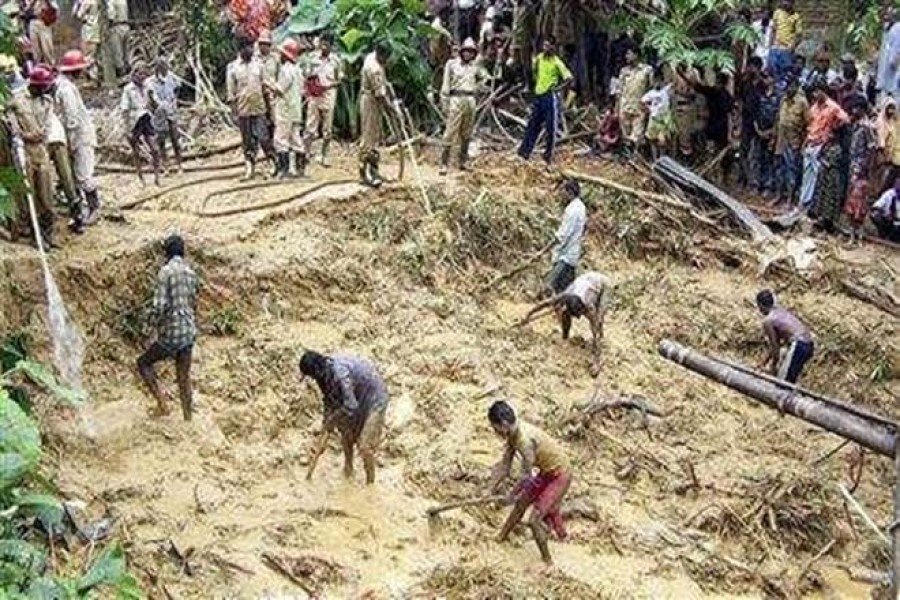Heavy monsoon rains have triggered a series of landslides in Rangamati and Bandarban. A number of these mudslides have claimed lives too, although the casualty figures are limited this year compared to the last year's worst such natural disasters. But this is small consolation. When an entire family perishes under the falling debris, the tragedy is no longer confined to it. The tragic impact has its human, social, economic, environmental and political dimensions.
Rains this year are not as incessant as last year's. If the sky gives in for a few days together, the possibility of a recurrence of landslides of outsize proportion cannot be ruled out. Already the communication between Bandarban and Rangamati has reportedly been snapped on account of huge debris on roads. The number of landslides has been quite high but luckily those did not fall upon many dwelling houses like it happened last year. Otherwise, the number of casualties could rise as well.
What is particularly noticeable here is that the incidence of landslides or mudslides in the hilly districts is on the rise. The clash between man and Nature is becoming intense and it is the former who is paying the price for undue encroachment. Here is a country that does not boast many tall hills. Whether it is in Sylhet or in Cox's Bazar, Rangamati, Chittagong and Bandarban, the undulating topography is dotted mostly with hillocks and sparsely some hills but no mountain.
Heavily populous, the country has continuously ravaged the hill's pristine nature by encroaching on the two regions. Building human settlement deep inside the hills and forests has gone on without any thought to the environment. Indigenous people habituated to living in those areas have known for generations how to cope with the apparently hostile environment without much interference with Nature. But settlers from plain lands have no such legacy of adapting to the surroundings without harming the natural resources.
Darjeeling, Kalimpong and Mongpu are some of the hill resorts in West Bengal, India. Those towns accommodate a large number of tourists almost round the year and still incidents of landslides on the way or in and around those towns hardly occur. Why? The most plausible explanation seems to be the rational exploitation of hills and mountains there. The roundabout roads built over hills, along rivers and through forests have taken as much space as required for the purpose. Trees, top soil and green covers everywhere have remained unspoiled. Trees standing like sentinels for miles together take one back to a hoary past where man is an outsider.
Why the hilly regions could not retain a similar unexploited character of the hills in the country's south-eastern and north-eastern regions is a troubling question. Instead, decimation of hills -at times the entire range -has gone on unabated. The Lalmai Hill has met the fate of total obliteration from the Earth's surface. The same process is followed in other hilly regions for building human settlements. Even hills were mowed down in Chittagong city for office accommodation. When the official stance on preservation of hills is this mindless, land-grabbers can only be expected to take the encroachment spree to the extreme. Last year a hill at its base was so delved deep that the top became too heavy for the lean base to support it any longer. The hill tumbled obstructing the slim flow of the river Karnaphuli.
Both private and commercial exploitation of hill areas has lead to denudation of hills beyond recuperation. Denuded hills cannot hold on -- particularly when soil is removed from their base or sides. Land-grabbers have been cutting hills in order to create settlements for poor and displaced people. Initially the aim is to occupy land, albeit illegally. Over the years they claim entitlement to the land by forging documents with the help of dishonest land officials. The unclaimed hills gone, the land then has an owner who builds infrastructure and encourages others to follow in his footsteps. Thus hills are falling prey to land-grabbers and losing their original character.
Such an oversight by the authorities concerned is best exemplified by the Batali Pahar in Chittagong. Many other hills have met similar fate over the years. But the authorities have turned a blind eye to the mayhem of hills and tree covers. Trees, herbs and shrubs keep soil of hills together and once those are removed, the dangling portion of hills or hillocks run the risk of crumbling when rainwater seep into soil loosening it.
The vulnerability of hills was proved even before the arrival of the Rohingya people. Their mindless cutting of bamboos and trees from around their settlements has posed a grave threat to the environment. Already a few of the Rohingya settlers have been injured by mudslides. Settlements built on the corridors of forests through which elephants pass have invited yet another type of problem. Elephants are unlikely to tolerate such interference. A couple of Rohingya were killed by elephants.
The problem here is the lack of respect for Nature's way. Hills damaged or destroyed have changed the contour of land in the regions. The Chaktai canal proves how devastating such mindless change can be. Chattogram's water-logging has now become an irresolvable problem. So let there be an immediate ordinance to the effect that cutting hill is a crime and appropriate law must be framed as early as possible to mete out punishment for the offence. Then the harder part of the task would be to give back the remaining hills their character through plantation of trees and other plants native to the area.


